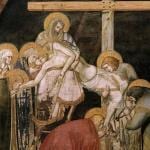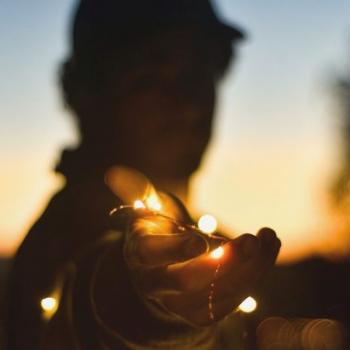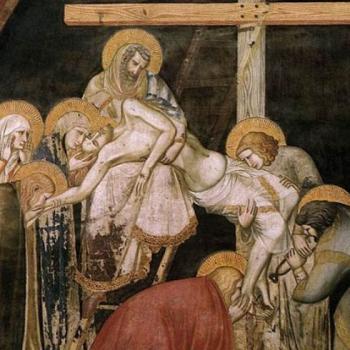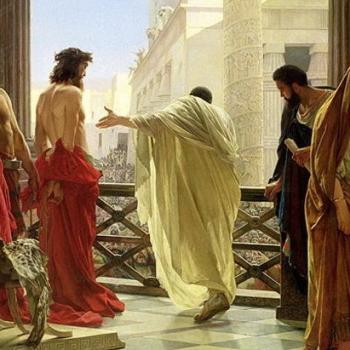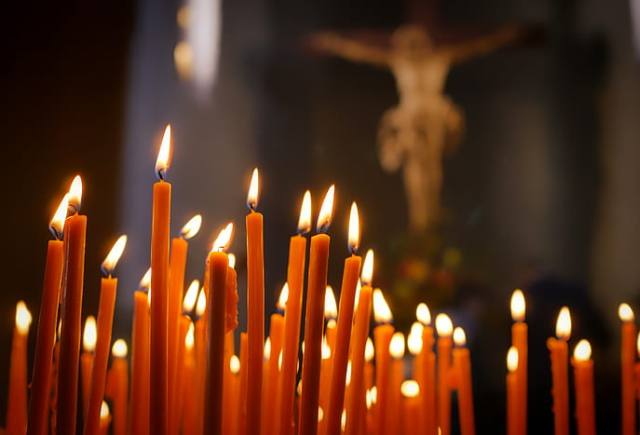
My childhood memories of Holy Week, when Christians the world over commemorate the Passion, Death, and Resurrection of Jesus Christ, are a kaleidoscope of images and impressions, turning from lighter colors to deepening hues. I dyed eggs and watched Peter Cottontail. I savored marshmallow peeps and beamed over My Little Pony toys in my Easter basket. I basked in the lengthening days, the freshness of the spring air in the house, and the way the sun warmed the earth after so long an icy absence. I loved the sparkle and promise of the season, the freedom and adventure of it all, with winter in the past and summer in the future, and a trip to grandma’s house likely somewhere down the pike. But I was always something of a story-teller, a story-weaver, and the darker undertones of the story of Easter soon drew me in and held me fast…
Coming from a practicing Catholic family, I also have early recollections of my first encounters with the story of Christ’s death and resurrection. I had a set of plastic colored eggs, all containing tiny items pertaining to the Passion: praying hands for Christ’s agonized prayer in the Garden of Gethsemane; a piece of leather for the whip that flogged His back; a crown of thorns for the cruel wreath the soldiers used to mock Him; a nail in place of the spikes used to pin his hands and feet to the cross; and a small stone in place of the great stone that was rolled in front of his tomb. But most memorable of all was the last egg, which was empty inside. The egg set came with a beautifully illustrated book telling the story of a little boy who witnessed Christ’s final week, collecting sorrowful mementos as he went.
Surprisingly, for a sensitive child, I never had difficulty delving into the Passion narratives, nor did my parents have to shield me from the brutality of the story. But this story of Christ’s death did haunt me like no other story could. During my homeschooling years, my mother would allow me to watch something either religious or educational while I ate breakfast. I would almost always pick Fr. Patrick Peyton’s production The Redeemer. It made an indelible imprint on me, a testament to the producer’s skill for storytelling and the sheer quality of the story itself.
Given that my parents still had to fast-forward sections of animated Disney films lest I become scared or upset, I still find it a strange how I was able to handle this raw retelling at such a young age, complete with the scenes involving the stomach-twisting callousness of jeering citizens and cackling soldiers as Jesus is being tortured and executed. The sound of the jeering and cackling remains burned in my psyche to this day. But perhaps being linked to the Passion has always been part of my calling, and the early exposure just helped me to see it reflected more often in the world around me.
There has always been a terribly painful thing about Good Friday in my memories, a terribly stark yet satisfying thing. It is an eerie thing, a strange thing, a feeling as if the veil between time and space really has been rent, and we are standing in the vacuum. As a child, I always felt a mix of dread and yearning. Of course, there was the fasting, the withholding from little pleasures that seem so large when you’re small. But in another way, it was the crux, the pinnacle, the central climax of the story by which all others took their shape, meaning, and reality in my mind. I believe it was an instinctive craving to enter into the very heart of the mystery, and yet, through human fragility and the sheer relentless pace of the modern world, I always felt woefully unable to do so in full. And that was why Good Friday was special: it lent us a glimpse of the inexpressible longing.
Some years I managed to satiate that longing better than others. In the parish church where I spent so much of my youth, I would wait in the long confession lines, looking up at the crucifix and realizing just how much it must have hurt. Yes, my house was full of crucifixes, being the daughter of a religious art dealer and restorator. But this one, hanging above me on in the church vestibule, seemed to be looking down on me through pain-blurred eyes while I said the Chaplet of Divine Mercy and penetrated my heart in a new way, like the bite of a spear through flesh. And I remember having to go to the store afterwards, and standing in the parking lot, looking up at the cloudy sky, I felt as if the entire hub of the world had stopped spinning on its axis, and I was all alone with my dying God.
I also remember the gnawing feeling in my stomach during our day-long fast, and finally in the evening, the scent of cooking fish sticks, golden-brown bread-crumbs and tender white meat, and being told about the symbol of the fish, bloodless pale, hearkening back to Christ’s own sacrifice of himself, unto the last drop, and the calling of the disciples from their nets on the shores of Galilee. And then there were the stories of persecution from Ancient Rome, and how the sign of the fish was our secret symbol in those days, our sign that set us apart as fishers of men and women. I remember mixing the tartar sauce, the smooth mayonnaise and tangy mustard and sweet relish, and watching some classic films such as The Robe and Quo Vadis that brought all these aspects together as a whole.
I remember my redoubtable music teacher, with her chapel veil and black coat, leading Latin schola for Good Friday services, and my knees on the floor that was painted with prisms from the stained-glass windows, turning to each station in the spacious church on the hill that to me has often felt like the centerpiece of my spiritual journey. I will always remember the sight of the altar, and the cross, with Mary and John mourning beneath it, and the angel statues holding the glass bowls of holy water, and the mesmerizing scent of that building, like carved wood and sesame seeds, I used to think. Perhaps it was the rafters or the pews, or a mix of both, heaven and earth joining there.
I also remember the way I would cry there sometimes, rejected from the cliques of my homeschooled peers, overcome with a bitter loneliness that simply wanted to be wanted. Perhaps I was being drawn more towards the divine will for lack of communal comfort, especially to cry out to that God who was all alone, outstretched on the tree. I remember the Passion Plays I took part in at various parishes. Much of the time, the events were clouded by my keen sense of being a marked outsider, of children snickering and giggling and sharing their secrets all around me, and doing everything in their power to keep me out. The fact that all the more prominent roles went to others and that I was always cast as one of the weeping women of Jerusalem seemed somehow appropriate.
Later on, I would finally play a role with a name: Veronica. And as such, I would step out of the crowd’s anonymity to wipe the blood from Christ’s face. I decided I very much liked that, being the one to do something suitably simple, suitably powerful, exposing the heart of what it means to be Christian. Wiping the blood from battered faces is a call none of us are too small to accomplish, even the least remembered in history, the least requested in popular circles. It was at this time I began to realize that my isolation was enabling me to value each person I encountered as some uniquely special gift from God, all of whom I was equally bound up with on an interior level. This, I would come to realize later, might be what centuries of mystics have called being a part of the Body of Christ.
As I grew older, I went to other parishes. I became good friends with the choir director in one of them, and his parish soon became closely associated with the feel of Holy Week for me. It was built by Catholic German immigrants in the 1890’s and bespoke awe and solemnity. And sometimes I cried there too, and pinned my pains to the wood of the cross in small, scribbled notes, most likely over a lost friend or dreams lived out by others instead of me. With the turning away of two close friends I had made in my teen years, the death of my beloved grandmother, and even the passing of my pet rabbit, I was learning that I took loss more keenly than I ever could have wished, although grieving was, and still is, a hard thing for me to process. The things that hurt the worst I often preferred to press deeper into myself and show the least.
At times, this morphed into dark nights of the soul. I would look up at the roof of Wal-Mart, see a nail hanging out, and think that if it fell down and I died, would it not be mere meaningless ceasing to exist of one breathing creature among so many? How would God be involved in the happenstance of a falling nail at all? And if He was not involved in that falling nail, how was He involved in anything? At times, such worries became so intense, I found myself enveloped by the horror that every impression of my mind was an illusory accident, and that everything was nothing. I wonder, now, if Jesus was assaulted by any of these thoughts when the nails were hammered through His hands and feet. Did He dread abandonment as much as I did, in all His humanity? Is that why He chose to quote the psalm He did upon the cross?
I had always been an all or nothing sort of person, and prospect of the latter, true nothingness, terrified me. No one could live without some belief in the fundamental meaning of reality without going mad. So I went to mass one day when the darkness seemed impenetrable, and the reading was based upon the message of the angel Gabriel to the Blessed Virgin at her Annunciation: “Be not afraid.” The tears filled my eyes, and I chose then and there to keep walking by faith, if not by sight, that there was a love waiting for me, even across the barren desert of desertion, if only I kept moving towards it with a steady insistence. I firmly determined to be nothing in favor of All.
I began a deeper exploration of universal spirituality, researching the mystical traditions of other religious traditions and cultures beyond my own. It took me everywhere, from Celtic Paganism to Buddhism to Judaism and Islam, and the friendships I made through reaching out have been invaluable to my development as a human being. Through them, I was able to learn about the wider web of spiritual storytelling that has been so vital to the humanity since our inception, and how even when doctrines differed, there was often an undergirding commonality found in the writings of the mystics that opened up a treasure trove of hope for me in some of my darkest hours of searching.
I knew that many young people were leaving the religion of their upbringing for other alternatives, but while I did broaden and deepen my interpretation of certain aspects, I never felt the urge to leave my Catholic faith nor cease being a Christian. Perhaps the main reason for this, in addition to various other factors, was Jesus Christ Himself who kept calling me back to the heart of the Universal Church, burst and bleeding and crowned with thorns. For wherever I turned, even in the bleakest moments, there I encountered Christ, and Him crucified. In Him, and through Him, I found the meaning of redemptive suffering which unites all suffering souls in solidarity with the cross in an ongoing flood of transformative love. And of course, that is the heart of what Easter has always meant to the faithful: Love will have the last word.
In no other religious tradition had I found something so starkly profound as an entity as overwhelmingly powerful as God emptying Himself into the form of a servant, through Jesus Christ in human flesh, and suffering the ultimate disgrace and degradation for his creation in order to bring about their redemption and offer them forgiveness, even in the midst of His own agony. This, for the Christian faithful, stands out as the ultimate act of empathy we are called to imitate, to greater or lesser extents according to our circumstances, over the course of our lives. We are called, like Christ, to submit ourselves to the will of the Father, and bear the weight of our individual crosses. It is a weighty thing, bearing the name of Christ for a Christian, but it is a weight of glory.
I remember my childhood Easters, the photos taken outside in the garden, ripe with colorful tulips and daffodils. I remember the trips to the shopping mall where I was allowed to pick out a stuffed animal to add to my collection, and I remember the strange reality of a gourmet chocolate shop, which made dark chocolate crosses for sale. This strikes me as rather perverse now, but perhaps not any more so than the term Good Friday, and the dark, thick, rich, bitter-sweet taste of that chocolate seemed to speak volumes through the senses.
I also remember the Easter Vigil masses, and how dead the church felt upon entering, for the tabernacle was empty and the holy water fonts poured out. It felt like the funeral of the world. And then the Paschal candle would be lit, and each of our small candles as well, each parishioner lighting the candle of the person next to them in the pews, until the whole church was filled with the flickering light. I would be afraid of the burning wax falling on my fingers, but loved to watch it drip down almost majestically onto the paper holder all the same, and feel the heat of the flame on my face. I loved the singing of the powerfully poetic Exsultet, and observing the ceremonies welcoming new members into the Church and renewing Baptismal vows. I basked in the singing of Handel’s Hallelujah, and standing for it as King George II of Great Britain had once done in honor of the King of Kings.
I also remember the Easter Sunday masses, especially at my home parish, and how it seemed the images of the saints in the stained glass windows would come to life, and how bright white the lilies looked, so very alive in comparison to white flesh of fish that marked our Lent, and how white the hosts looked, now returned to the tabernacle, and how as I grew older, I chose to receive it kneeling on such resplendent days as this. I also remember my family and I going out afterwards to celebrate at an Italian restaurant, with chicken fettuccini and olive salad and lemon crème cake, tapping down into the roots of our heritage, not just ethnically but also spiritually. After all, it was in Italy where St. Peter walked the Appian Way and encountered Christ with his cross. “Quo vadis, Domini?” Peter asked then. And should we not all ask where the Lord is going, and how we might follow?
Easter is living, moving, dynamic. It is a story that is real with fresh-cut emotion and a truly multi-faceted and all too human cast of characters who you cannot merely observe with disinterest, for they are already in us and we are in them, for good or ill. It is a story meant to live again in each retelling, and remind us of things are soul knows, though our minds might too easily forget. It is meant to unsettle as much as to heal. This is the test of a truly worthwhile story. Perhaps the popular genres of romance and horror have some root search for a deeper stream running beneath, even if they rarely strike water. They mean little to nothing if they fail to stir us to empathy, compassion, and self-giving love. They mean little if they do not offer us hope. That is why this story, of this Son of Man, is both the Great Romance and the Great Horror, for it contains the seeds of all our experiences, from the most sublime to the most surreal, and reconciles them at the root of all things.
As a writer, I have dealt in these subject often in the stories I craft. Frequently I deal with death, the greatest of mortal fears, and the height of the mystery of self-emptying. For it is always an outpouring, down to the last drops of ourselves, until we are but mist. And we, as rain, must trust that we will flow into the sea from whence we came. Too often in the world of fiction, dealing with this frightful unknown has led to a macabre relishing in the darkness without any deeper understanding being touched upon. But the Passion is not like that, and yet within it every death is contained and crystallized and revealed for what it is. I try to do the same in my stories.
I have been called, in jest by friends, “The Queen of Death Scenes”. But the very kindest compliment one could pay me is that, in some glimpse or glimmer, they see Christ’s death come through these sub-creations, that some tragic beauty has pierced through to them and called their mind to the cruciform reality within their own souls that unites them to all others. Some might think it strange to wish Christ to be seen in all characters, the good and the bad alike, but for a Christian, to know Christ is to love Him and to love Him is to see Him in everyone, in everything, and to love all things accordingly, for He is the one through whom all things hold together, who knows us better than we know ourselves, and who is closer to us than our own consciousness.
All this being as it is, I still have not even begun to unpackage the full effect of the Easter story not only on my own life but on the history of the world. Entering into the mystery once again as the annual liturgical cycle rolls round, I would like to walk deeper yet into the labyrinth of Christological mysticism. It is my prayer we may walk together down the road to Emmaus, and find the face of Christ hidden within the faces of each other. For the mystery of Easter is one which puts me in the heart of Christ’s Body, and therefore puts all of your hearts in mine. It is this perfect love that casts out all fear. The tomb is empty and the light has penetrated even the darkest corners of mortal existence, even unto non-existence, even unto death itself. And we need never walk there alone again.

